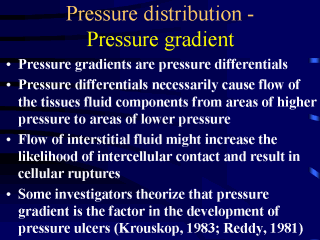 |
Pressure
gradient describes the amount of change in pressure over a distance. If the pressure
across a surface were plotted, the pressure gradient would be the slope of the curve.
Since the skin and other soft tissues at risk of breakdown consist of a mixture of fibrous
collagen network, interstitial fluids, blood vessels, lymphatic vessels, and other
elements, a pressure differential between adjacent regions will result in a flow of the
tissue's fluid elements from one region to the other. Several investigators have
hypothesized that the flow of interstitial fluid caused by pressure gradients is the
primary factor in the development of pressure ulcers (Krouskop, 1983; Reddy, 1981). The
flow of interstitial fluids from an area of high pressure is believed to increase the
likelihood of intercellular contact resulting in cellular ruptures (Mak, 1994; Crenshaw
and Vistnes, 1989; Krouskop, 1983; Reddy, 1981). This theory is consistent with the
classic experimental results of Kosiak (1959), Daniel, Reswick and Rogers showing a
relationship between duration of pressure application and the magnitude of pressure that
results in the formation of a pressure ulcer. Pressure gradient is intimately linked to
pressure and is affected by immersion and envelopment in a similar manner. Although, under
certain circumstances, it is possible to have high pressure gradients without high
pressure, and vice-versa. For example, at the boundary of the contact area on a support
surface there is necessarily a significant pressure gradient where the pressure magnitude
transitions from zero outside the area of support to a non-zero value in the supported
region. Despite these relatively high gradients, these boundary areas are typically areas
of lower risk for pressure ulcer development. This suggests that pressure gradient only
becomes an important factor when combined with high pressure. Research is necessary to
test and investigate this hypothesis. |
